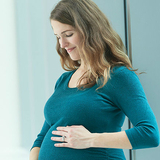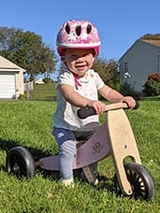Omphalocele Discovered During Pregnancy: Grace’s Story
Omphalocele Discovered During Pregnancy: Grace’s Story
When Addie and Ryan first learned the child they were expecting had a birth defect, their obstetrician warned them that, in addition to a host of health issues, their baby wouldn’t have a belly button because of the condition. Looking back, Addie is grateful for the pediatric surgeons at CHOP who not only deftly repaired her daughter Grace’s birth defect, but also had the forethought to give her a belly button.

When the obstetrician (OB) told Addie and Ryan their fetus had an omphalocele, they were devastated. An omphalocele is a birth defect in which parts of the bowel, liver and other abdominal organs extend into a sac outside the belly.
The OB suggested the couple seek care two hours southeast at Children’s Hospital of Philadelphia (CHOP), where a highly specialized team in the Richard D. Wood Jr. Center for Fetal Diagnosis and Treatment helps families facing the condition on a regular basis.
“It was a whirlwind of emotions, but knowing there was a place where this wasn’t unheard of was very comforting,” says Addie.
The couple traveled from their home near York, Pa., to CHOP for a full-day evaluation at the Center, where they learned that it was a large omphalocele. They returned for follow-up appointments until Grace was born via C-section in CHOP’s Garbose Family Special Delivery Unit (SDU). The SDU is the world’s first birth facility designed exclusively for pregnancies complicated by birth defects.

Delivering at CHOP
Learn about what sets CHOP’s Garbose Family Special Delivery Unit apart in the care of mothers carrying babies with prenatally diagnosed birth defects.
After birth, babies with omphalocele are immediately passed to CHOP’s unique Neonatal Surgical Team, which is waiting in an adjacent room, poised and ready to stabilize them and provide the expert care they need before going to CHOP’s Harriet and Ronald Lassin Newborn/Infant Intensive Care Unit (N/IICU).
Omphalocele treatment and recovery in the N/IICU
Once Grace was in the N/IICU, the Neonatal Surgical Team began the process of returning her abdominal organs to where they belonged inside her belly. The omphalocele was wrapped with wet gauze and, over the course of 10 days, the sac holding the intestines descended down into Grace’s abdomen. A pediatric surgeon then performed a primary repair, putting the organs back into place in the abdominal cavity and closing up her belly in one stage.
Grace spent a total of three months in the N/IICU overcoming breathing issues, and she had to have a G-tube surgically placed in her stomach due to feeding issues.
For a while, Addie and Ryan weren’t able to hold Grace. Knowing how hard that is for new parents, the nurses in the N/IICU taught the couple other ways to bond with their baby, like reading and singing to her and holding her hand.
Going home and getting stronger

Thanks to those daily reading lessons in the N/IICU, Grace developed a love for books. After discharge from the N/IICU, Grace did virtual physical therapy to practice tummy time, rolling over and sitting up.
She is now a happy, healthy 16-month-old whose love for books keeps growing. She has graduated from physical therapy and no longer has a G-tube. She is meeting all of her milestones and “is a great little eater,” says her mom.
“She’s come such a long way,” says Addie. “The people at CHOP are the best of the best.”
When Addie and Ryan first received Grace’s diagnosis, their obstetrician had warned them their baby wouldn’t have a belly button due to the omphalocele defect. Addie is so glad that the pediatric surgeons at CHOP had the forethought to give Grace a belly button when they surgically closed her belly.
“They really go beyond the medical problem and think about the whole child,” says Addie.